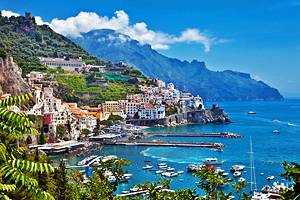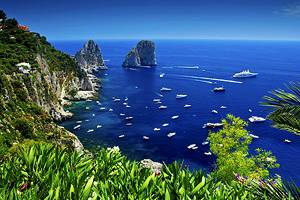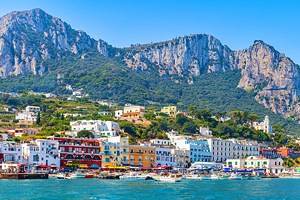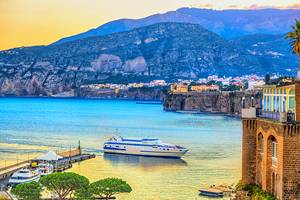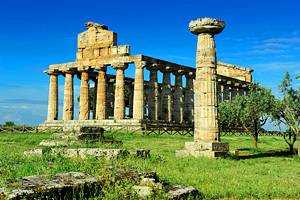Day Trips from Sorrento
Sorrento's location on the Bay of Naples is not only a beautiful one, but it's well positioned as a base for exploring the entire region. The Bay of Naples and the Amalfi Peninsula, which forms its southern shore, are lined with some of Italy's best known tourist attractions.
One of the most popular things to do here is hop on a boat and travel to Naples, the idyllic Isle of Capri, or the Amalfi Coast. The Circumvesuviana train takes you to Pompeii and Herculaneum, and from either of these, it's a short bus ride to Vesuvius, the mountain that destroyed both of these ancient cities.
Plan your adventures and find the best things to do with this list of the top day trips from Sorrento.
Pompeii

Uncovered after lying for centuries encased in a thick layer of solidified volcanic ash that engulfed the town of 20,000 residents in AD 79, Pompeii gives a poignant look at life in ancient Roman times. You can walk through homes, meeting places, temples, theaters, and shops that have been coming to light since excavations began in the 1700s. As you tour Pompeii, you can't help but be aware of still-smoldering Mount Vesuvius looming in the background.
Several of the homes still have vivid wall paintings, frescoes, and mosaics, and statuary still adorns the gardens. Although early finds were carried off to museums, those found more recently have been left in place to give a more realistic picture of homes and workplaces just as they had been left on that terrible day.
Amalfi Drive

Although it's only 48 kilometers long, the Amalfi Drive is one of Europe's most beautiful - and rightly famous - stretches of coastline. You could easily spend a day or longer enjoying the scenery and the little towns that cling to its steep slopes overlooking the intensely blue Tyrrhenian Sea.
Deep ravines cut into the mountains that form the spine of this narrow peninsula, so the road follows a curving course as it rounds each point and dips back into the coves. In many places it is carved into a corniche that is poised almost directly over the sea. Driving it is not for the timid, but especially in the west-to-east direction, which means driving in the outer lane.
The Amalfi Drive has few stopping places, except in the towns, so to see the most scenery, taking a tour or a bus might be the best idea. Be sure it's one that stops in at least one or two towns, so you can climb their vertiginous streets and stop in a café to savor their holiday air. Or follow one of the ancient mule paths along the coast, walking through lemon groves and tiny hamlets clustered against the steep mountains.
Capri

Ferries run regularly from the harbor at Sorrento across the Gulf of Naples to the romantic island of Capri, or you can take a day tour.
From the Marina Grande, where the boats land in Capri, you can make reservations for a boat to the Blue Grotto, a sea cave that is one of Capri's best-known tourist attractions. Or you can ride the funicular to the main town. Here and the smaller harbor of Marina Piccola are the best places to spot celebrities that frequent the island.
For lofty views of the Faraglioni sea stacks, in the sea off the Marina Piccola, stroll the blossom-draped paths of the botanic gardens near the monastery of San Giacomo. A bus will take you higher yet, to the uppermost town of Anacapri, where the gardens of the Villa San Michele frame views of the sea and other side of the island.
Amalfi Coast Cruise

You'll get an entirely different – and just as beautiful – perspective of the Amalfi coastline from a tour boat. And on the trip from Sorrento, you will also round the far end of the peninsula, where the Lattari mountain range ends abruptly at the sea.
Choose a cruise that has at least one stop, which will probably be at Positano or the town of Amalfi, so you can get a feel for the towns and enjoy views from the land as well as the sea. Amalfi coast cruises often include a cruise around the island of Capri, too.
Herculaneum

The same AD 79 eruption of Mount Vesuvius that covered neighboring Pompeii in hot ash encased Herculaneum in molten lava. As it flowed, it filled in Herculaneum from the bottom up, so instead of its weight crushing structures as the sudden rain of ash did in Pompeii, it supported columns and walls as it rose, holding them in place.
This lava - from 12 to 30 meters deep - hardened into pumice, a light-textured stone that held everything in place until modern techniques could release them. Fortunately, by the time excavation unearthed Herculaneum, modern ideas of protecting ancient monuments and preserving artifacts in place had also taken hold.
Today, you will see entire streets of multi-storied homes and public buildings that have been excavated, complete with mosaics, decorative friezes, and paintings that have not been carried off to museums, as much of Pompeii's treasures were. In addition, the airtight seal of cooled lava preserved organic materials, which add to the surprisingly vivid view of Roman life.
- Read More: Visiting Herculaneum: Attractions
Naples

Even for exuberant Italy, Naples is on sensory overtime. Everything seems to be happening in its chaotic streets, where social, commercial, and everyday life blend in perpetual motion. The aromas of its famous pizza, the sounds of laughter and music, the colors of painted stucco intensified by the southern sun all swirl around you as you climb through its neighborhoods.
Get a better understanding of Pompeii from admiring the artifacts and art that were brought from its excavations to the National Archeological Museum. The Capodimonte Royal Palace and Museum displays more treasures of the city's long history, which spans from Greek settlement in the eighth century BC and includes rule by Byzantine, French, Spanish, and Austrian empires.
Along with its palaces, Naples has a rich artistic heritage in its cathedral and many churches. You can only hope for a sampling in a day trip here, but it's a day you'll remember.
Ravello

High above the deep Valle del Dragone ravine near the town of Amalfi, Ravello was once much bigger than it is today. Its prominence in the early Middle Ages has left it with monasteries, palaces, and villas, and the 12th-century church of San Giovanni del Toro, with ancient frescoes in the crypt and a beautiful mosaic pulpit. The cathedral, which dates from even earlier, has a pair of exquisite inlaid pulpits.
But for all the riches in its churches, what you'll remember longest are the views from its gardens down into the sea far below. Now parks open to the public, these surround lavish villas. Villa Rufolo's oldest part is a huge stone watch tower, and the ruins of the rest have been incorporated into the gardens or restored to house art exhibits and concerts.
Villa Cimbrone's gardens have perhaps the finest views of the Amalfi coast, from the Belvedere Cimbrone, reached by a tree-lined promenade through the gardens. Alongside this avenue are smaller gardens hidden among the crumbling walls and highlighted by statues, fountains, columns, and even temples that were collected by its early 20th-century English owner.
Vesuvius

The volcano that engulfed the cities of Pompeii and Herculaneum forms a dramatic backdrop to the Bay of Naples, a favorite take-home photo for tourists in Sorrento. You can get up close and personal with Vesuvius by taking a bus from either of the two excavated Roman cities or driving to the Vesuvius National Park, about 1,000 meters in altitude and about 200 meters from the top.
From here, you can climb to the rim and look into the crater. You can walk all around the rim for views of Naples, the bay, and the Amalfi peninsula. The volcano is still somewhat active, although the last major eruption was in 1944.
Ischia

Larger and less crowded than Capri, Ischia has better beaches and plenty of island charm. It sits in Naples Bay, and a morning ferry can take you here from Sorrento, returning in the late afternoon.
The town of Ischia, on the northeast coast, has two sections. Ischia Ponte is topped by the Castello atop a 91-meter rocky crag, which you can visit by crossing a stone causeway; the original castle here was built in 474 BC. The other part of town is the seaside resort of Ischia Porto, whose harbor is formed by an ancient volcanic crater.
From Forio, on the west coast, you can tour the quiet southern part of the island, where the village of Sant'Angelo seems to be tumbling down a promontory. Stop to see La Mortella, beautiful gardens created by Susana Walton and British composer Sir William Walton.
Hike the Path of the Gods

Footpaths and old trails form a network for walkers along the mountainsides high above the Amalfi Drive, revealing an endless series of views over the rugged coast and the sea. The most popular section of these trails is the Sentiero degli Dei, Path of the Gods, beginning in Positano.
You can take a bus from Sorrento to Positano to access the trail.
Spend a Day Fishing

Board a boat at Sorento's lively marina and spend a day sailing around the magnificent coast of the Sorrentine Peninsula, fishing for some of the region's fabled seafood. On a sea-fishing tour from Sorrento, you'll not only have the thrill of catching fish, but your boat will stop in Positano while the crew prepares lunch of the fish you caught in the morning.
The leisurely trip includes time for a swim or snorkeling in the crystal-clear water, or just relaxing on board and watching some of Italy's most beautiful scenery as you sail. If needed, the guide will assist you in fishing, and all equipment is provided. The full-day tour includes transportation direct from your hotel.
Map of Day Trips from Sorrento
More Related Articles on PlanetWare.com

Where to Go from Sorrento: If Rome and the ancient world of Pompeii and Herculaneum have whetted your appetite, head south to visit the temples of Paestum, founded by Greeks around 600 BC and the finest remains of Greek architecture in mainland Italy. Or take a ferry from Naples to tour the outstanding ancient Greek and Roman attractions in Sicily.

More Places to Visit in Southern Italy: Although much less visited than the western coast, Puglia's Adriatic coast is one of the top beach destinations in Italy. And for sightseeing, Lecce - at the heel of the Italian boot - is known for its abundance of Baroque architecture.


